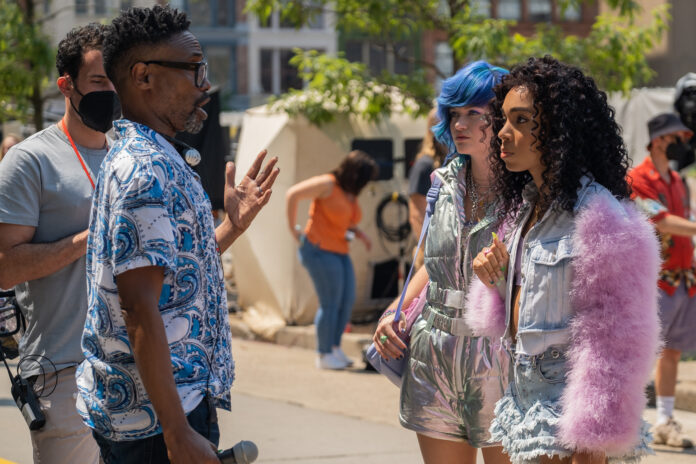
Billy Porter brings style and verve to his directorial debut with the upbeat romance, “Anything’s Possible.” The film, dropping July 22 on Prime Video, has trans teenager Kelsa (trans actress Eva Reign) falling in love with her classmate Khal (Abubakr Ali). Their relationship is sweet, but it does cause Kelsa trouble with her friend, Em (Courtnee Carter). Moreover, Kelsa’s overprotective mother, Selene (Renée Elise Goldsberry), gets upset when one of her daughter’s videos about being trans goes viral.
Porter’s film, written by Ximena García Lecuona, makes salient points about gender — there is a subplot about Kelsa being asked to use a gender-neutral bathroom (in the basement) — as well as how trans youth adapt and navigate friendships and relationships. Thankfully, “Anything’s Possible” never feels preachy. Reign infuses Kelsa with charm and self-worth, and Khal is a genuinely nice guy who cares too much about others and learns to care more about himself.
The film also features fabulous costumes and some fun sequences at the Phipps Conservatory and Botanical Gardens as well as the Warhol Museum.
In a recent zoom interview, Porter spoke with PGN about his entertaining new film.
Why did you choose this project for your directorial debut? What makes this “A Billy Porter Film?”
This project chose me. I chose myself decades ago. I have been living authentically for decades now. When the producers, Christine Vachon, David Hinojosa, D.J. Gugenheim, and Andrew Lauren got this script from their intern, Ximena, apparently, I was the first person who popped into their heads, so it found me.
You have a fun style here, from the fluid camerawork and lively editing, but you also do the emotional moments, such as a scene between Khal and his mom Selda (Miriam Laube), well. Can you talk about your energy and approach to the material? And there is a fabulous dance scene during the end credits!
I do have a personality. I have a voice and a language that is uniquely my own. I brought my team — my hair person, my makeup person, my DP, my costume and set designer — and we talked about visually making it celebratory. We wanted the celebration of transness and the joy of transness to be visual as well. That’s how I approached it.
When I was a teen there were too few queer films and certainly nothing like this. What can you say about the importance of visibility and representation particularly for queer youth?
What I’ve been talking about recently is, with all the devastating news that we are living through, the focus is all on the negative. What we are not talking about is that progress has already been made. That is why the pushback is so severe. Progress has been cemented into the culture. Just as you said, there was no such thing as a movie like this when we were growing up. There is now!
You are one of the few Black filmmakers, gay or straight, working behind the camera these days. What can you say about that responsibility?
As artists, we have the power to hold a mirror up to society and hold society accountable through stories, music, visual art, books — that’s what we get to do. We’re healers. Toni Morrison said, “This is precisely the time when artists go to work. There is no time for despair, no place for self-pity, no need for silence, no room for fear. We speak, we write, we do language. That is how civilizations heal.” This movie is a representation of that.
The film is very much about defying the expectations that are placed on us, be they gender roles, racial/ethnic expectations, and other factors. Can you talk about the importance of this both in the film and in life in general?
Representation allows for those of us who don’t feel seen, for those of us who feel alone, to understand that we’re not. It also teaches others on the outside of the margins — very often the oppressors — what it feels like to be us. That’s the power of art. We have the power to reach into hearts of people and change the molecular structure from the inside out, and I am so very proud that this movie does that. This film is about the normalizing of the other. It is. When people see that, the hope is that there’s a softening, a push back on tolerance, a push back on acceptance. Those words make me bristle. What my goal is, is to help people understand that we can agree to disagree, but we’re all humans first, and the respect for everybody’s humanity comes first. Human equality. Tolerance and acceptance puts the validation of our lives in somebody else’s hands. It’s time for that to be over.
What can you say about the fabulous costumes and the music, which I understand you produced?
I wanted to create an aspirational tale of what the world could — and should — look like. And that needs to look a very certain way. I do have an aesthetic and it is my movie, so I tried to make that happen.
Kelsa talks about animals and how they are unique and able to survive. What animal are you?
I am a peacock, because they are pretty, but that’s, like, the obvious. I would also say a panther.